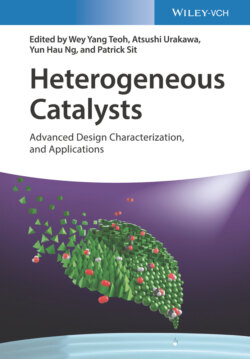Читать книгу Heterogeneous Catalysts - Группа авторов - Страница 70
5.5 Conclusion
ОглавлениеThis chapter has covered atomically precise metal clusters made using physical (UHV) and chemical approaches. Catalysts containing cluster‐like species as active sites with respect to their size regime (e.g. sub‐3 nm) can be made using conventional methods, but in this case, it is rare that atomic precision is reliably achieved as a range of cluster sizes can be formed since such methods lack precise control over particle size. Deposition–precipitation using heated solutions containing urea, which gradually decomposes, releasing ammonia that slowly increases the pH, seems to be promising method for making supported metal clusters [80].
One interesting area of making cluster‐based catalysts is focused on fabrication of clusters in porous materials, such as zeolites [81] and metal–organic framework materials [82] (see Chapters 7 and 8). The idea is that growth of the clusters (starting from simple mono‐atomic precursors) is confined by the size of the cavities available. Although the chemistry of clusters in zeolites is well developed with an additional bonus of clusters interacting with H+ in forming metal cluster‐proton adducts acting as “collapsed bifunctional sites” capable of both acid and redox catalysis [81], true atomic precision of such species can be hard to achieve. Recently, the [Cu3(μ‐O)3]2+ cluster in zeolites attracted significant attention owing to the interesting catalytic chemistry in the conversion of methane to methanol [83, 84]. Yet, there are studies that demonstrate that the presence of larger CuOx particles (up to 3 nm) in such catalysts could also be active [85, 86].
Clusters supported within zeolites can undergo dynamic particle changes during catalysis, as was demonstrated by detailed high‐resolution electron microscopy study of Pt clusters in zeolite MCM‐22 [87]. In fact, it may be questionable if zeolite frameworks can truly limit cluster growth since it was demonstrated that the formation of truly large NPs within zeolite crystals does damage zeolite frameworks. Interestingly, such damage coincided with increased catalytic performance, which was interpreted as improvement of the mass transport‐limited reaction (by overcoming the narrow pores of the zeolite framework) [88]. Finally, clusters assembled in metal–organic framework materials could potentially become new high‐intensity research area due to molecular‐based nature of the framework complementing atomic precision of metal clusters [82]. There is evidence of promising high stability of such catalysts [82]. Ultimately, the control over cluster assembly with the help of functional groups built within a framework could be achieved with clever design of the framework.
